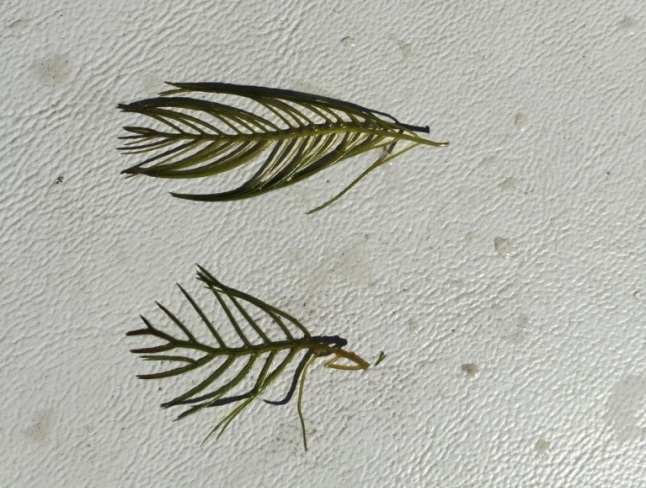
What alien invasive species has been detected in Lake Revelstoke Reservoir?
A — Quagga Mussels;
B — Zebra Musells; or
C — Eurasian Milfoil?
If you answered Quagga and/or Zebra Mussels you’d be wrong. But if you answered C — Eurasian Milfoil — you’d be the big winner.
Last autumn, the Columbia Shuswap Invasive Species Society completed invasive plant and mussel detection surveys in high-priority lakes in the North Columbia. To date, the analyses from Lake Kinbasket, Lake Revelstoke, The Upper Arrow reservoir, and the Columbia River all came back negative for Zebra and Quagga Mussels.
However, invasive Eurasian Water Milfoil was detected in Lake Revelstoke, near the Martha Creek Provincial Park boat launch. Our surveys confirmed earlier studies by BC Hydro and the Ministry of Forests, Lands, and Natural Resource Operations that originally found this site infestation.
Invasive milfoil and invasive mussels take over riparian and recreational water areas, making it dangerous and difficult for swimmers and native aquatic life. Eurasian Water Milfoil is found throughout the Shuswap Lake region, and the CSRD runs a program funded by Shuswap residents to manage milfoil infestations at public recreational areas.
“Invasive Zebra and Quagga mussels have not been detected in British Columbia, and are a real threat to our economy and environment: it would cost millions of dollars annually to maintain infested hydro-dam and water-valve infrastructure; in addition, invasive mussels would pollute our beaches, and decimate native aquatic life,” says CSISS Program Manager Robyn Hooper, “It is illegal in BC to transport invasive mussels on your watercraft.”
“The Eurasian Milfoil site at Martha Creek goes to show that we need to constantly be on the look-out for new invaders threatening our lakes and rivers,” says the CSISS Executive Director Natalie Stafl, “We encourage all watercraft users to properly clean, drain and dry their equipment to protect our waters.”
The Columbia Shuswap Invasive Species is working with the appropriate jurisdictions and stakeholders regarding a strategy for the Eurasian Milfoil infestation in Lake Revelstoke, under the guidance of the Canadian Columbia Basin Aquatic Invasive Species Framework. CSISS is planning more invasive plant and mussel detection surveys for 2016, and is excited to have Laura Gaster back with the CSISS staff team as the new Aquatic Invasive Species Program Coordinator this spring.
The Columbia Shuswap Invasive Species Society is a non-profit organization dedicated to the prevention, management and reduction of invasive species in the Columbia Shuswap Regional District.
To learn more about invasive species in the Columbia Shuswap region please visit: http://www.columbiashuswapinvasives.org



